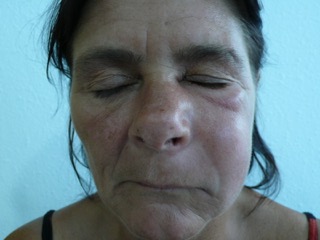Do You Have a Dental Abscess?
Tooth Abscess Treatment Explained
A dental abscess is caused by an infection within a tooth. You can get a tooth infection from 2 possible sources, and the correct tooth abscess treatment depends on your dentist tracking down the correct real cause!
What you will normally notice is a painful tooth, especially when you bite or put pressure on it. Sometimes, especially with front teeth, it is tender when you tap on the tooth firmly with the tip of your finger. You might also notice that the gum right next to the tooth is sore to press on. The gum may also be a little swollen or puffy.
 A man with a dental abscess
A man with a dental abscessYou might also get some swelling around the tooth. If the infection has started to spread, you can get a swollen face, and in extreme cases a swollen neck with breathing difficulties.
What about the 2 possible sources of infection that can cause a dental abscess?
Dental Abscess - the causes
Either
- The tooth nerve has died, leaving a dead nerve inside the tooth. You have a dead tooth. The dead nerve tissue inside the tooth slowly decays, as bacteria multiply. Take a look at that page!
There's NO blood supply inside a tooth, so your immune system can't do anything. Eventually the bacteria get out of the tooth and into the jawbone at the tip of the root. Here they continue to breed, and start to break down the bone around the root tip. This is an abscess on the tip of the root.
The tooth is painful because the abscess causes pressure inside your jawbone, at the root tip. When you press on the tooth, or tap on it, you're actually pressing the tooth into the abscess, causing pain. It's a bit like pressing in a splinter in your finger.
 swollen face caused by a dental abscess
swollen face caused by a dental abscessBut there is no pain if you have a hot drink or a cold drink. This is beacuse there's no nerve inside the tooth. The nerve has died. The pain you feel comes from the nerves around the tooth, in the jawbone.
OR
- You have gum disease, which means your gums do not sit tightly against the necks of the teeth. There is a small gap under the gum. We call it a pocket. Bacteria and plaque collect in there, because no normal brush NOR mouthwash can get in there.
At some point, the bacteria start an infection which can't drain out through the top of the pocket, and you get a small lump coming up on the gum. This is a gum abscess, and this is caused by gum disease. The tooth itself may be perfectly healthy. It's the GUM that is the problem!
This sort of gum abscess can also come up around a wisdom tooth that is sitting halfway through the gum. This is because the gum does not sit tightly around the tooth, allowing plaque bacteria and possibly food debris under the gum.
Dental Abscess
There are a few clues that might tell you.
- If you get any pain with a hot drink or a cold drink, then the nerve in the tooth is not dead. If you just have a swollen gum, then you probably have a gum abscess.
- If the tooth is painful when you put your teeth together (without any food in your mouth), then the nerve is probably dead, and you likely have an abscess on the tip of the root.
What does this difference mean?
Tooth abscess treatment:
Because both types of dental abscess are caused by bacteria, they can be treated with antibiotics, at least initially. The difference is in the best antibiotic for each. Read more about this at Tooth Abscess Antibiotics.
The first choice of antibiotic for most dental infections is a type of penicillin Amoxicillin (Amoxyl). Sometimes this is packaged with cluvanic acid to make Clamoxyl, which is more resistant to being broken down by stomach acids.
If you are allergic to penicillin you may be given Erythromycin or Clindamycin as an alternative. Clindamycin is especially good at penetrating bone, and is used where there is a deep bone infection.
Final tooth abscess treatment will take a bit more than antibiotics, though. Generally speaking, a dead tooth will either need root canal treatment if you want to save it, or else you will need to get the tooth removed.
A gum abscess next to a tooth will need some sort of gum treatment, usually with a dental hygienist. This involves several visits to clean under the gum where the problem is, to settle the gum down. Then the hygienist will need to show you how to clean your teeth better, to prevent an abscess coming back.
I hope my guide to a dental abscess has been useful.
I explain root canal procedures Here.



